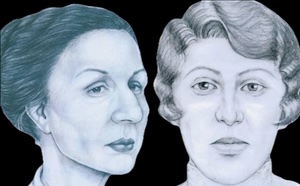Summary
In June 2006, the skeletal remains of an unidentified individual were found by work crews who were excavating fuel tanks from an old gas station in Sutherland, a neighborhood in the Canadian city of Saskatoon, Saskatchewan. The Saskatoon Police Service responded and began investigating. A clothing and textile historian assisted police with dating the woman’s clothing, which included a fitted jacket, high-collared blouse, and a long skirt, to between 1910 and 1920. A broken golden necklace and a man’s vest and trousers were found with the woman's remains. These clues led investigators to conclude that the remains belonged to an adult woman who died sometime in the early 1900s.
The woman's body was wrapped in a burlap sack and stuffed into a wooden barrel. The barrel had been dropped into a well at the site of the Shore Hotel, a local business that existed in the early 1900s. The Shore Hotel was a boarding house with a mixed reputation in the bustling railroad town and it was demolished in 1927 and a gas station, with fuel tanks, was later built on the site. At the time, Sutherland was a railroad town near the growing city of Saskatoon. Police believe that the woman was partially dismembered prior to being placed into the barrel.
After the discovery of the woman's remains in 2006, the Sakatoon Police Service pursued a lengthy investigation to determine who the woman was including enlisting a forensic archeologist at the University of Saskatchewan who determined that the woman was White with a prominent nose and light brown to reddish hair, between the ages of 25 and 35 years old, and around 5'1" tall. It is believed that the woman was of middle class or higher because of the clothing, jewelry, and dental work she had. 
Over the years, investigators worked tirelessly to identify the woman. An STR DNA profile was developed for the woman, but there was no match to a known individual. Police unveiled two facial reconstructions hoping that someone might recognize the woman from old family photos. These efforts led to police receiving about 30 calls from people across Canada and as far away as France looking for a missing mother, grandmother or great aunt, but no match were made. The woman's identity was a mystery.
In 2023, the Saskatoon Police Service submitted forensic evidence to Othram in The Woodlands, Texas to determine if advanced DNA testing could help identify the woman. Othram scientists successfully developed a DNA extract from skeletal evidence, which were well over 100 years old at the time. Othram's scientists then used Forensic-Grade Genome Sequencing® to build a comprehensive DNA profile for the unknown woman. Othram's in-house forensic genetic genealogy team used the profile in a genetic genealogy search to develop new investigative leads that were returned to law enforcement.
Using this new information, forensic genetic genealogists with the Toronto Police Service conducted a follow-up investigation leading investigators to potential relatives of the woman. Reference DNA samples were collected from potential relatives and compared to the DNA profile of the unidentified woman. This investigation led to the womans' positive identification. "Woman in the Well" is now known to be Alice Spence, born Alice Burke in September 1881.
Alice moved to the town of Sutherland, Saskatoon in 1913 from St. Louis, Minnesota. The Spence family consisted of Alice, her husband Charles, and young daughter Idella. A 1916 Census is the last record investigators have found indicating Alice was alive. A fire in 1918 destroyed the family’s home and later information lists Charles living with his daughter, a housekeeper, and her son in 1921. Investigators believe foul play occurred resulting in Alice’s death, sometime between 1916 and the fire in 1918. Using genetic genealogy, Alice’s descendants have been located. Most of them were unaware of her and her tragic death.
This case is a reminder that every piece of forensic evidence has the potential to unlock long-awaited answers. If you would like to support efforts to solve more cases like this, consider contributing your DNA data to the DNASolves database which aids law enforcement in identifying long lost people, like in this case.
The identification of Alice Spence represents the third case in Saskatchewan where officials have publicly identified an individual using technology developed by Othram. Visit DNASolves to learn about other Canadian cases where your support can help bring long-awaited answers to families.
